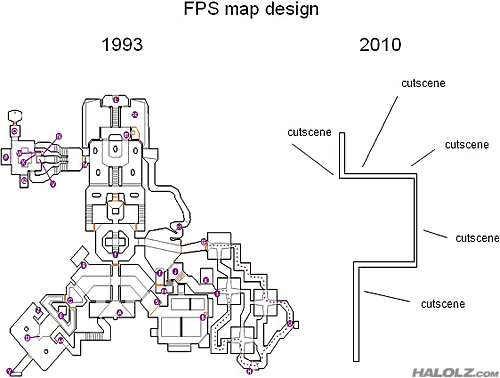I think that, at least to some degree, it's important to factor in development costs when you consider the 'dumbification' of games. Sure, accessibility is becoming more and more important as time goes on, but there's also the very real fact that the costs associated with making a game are ballooning. Back when Doom came out, games were developed by pretty small teams of people, and many art assets were still sprite based (and what true 3D elements there were were all pretty simple). Now, todays games are made by significantly larger teams (all of whom have to be paid, obviously) who are working with significantly more intricate details. This is a large part of why we're seeing more linear games with fewer enemy types in them: each branch in a path is another whole area which needs to be fully detailed and fleshed out, and must look and play differently from the other path. This takes a lot of time and money. Plus, putting a full menagerie of enemy types in involves actually MAKING those enemies, which means making the models, the animations, the sounds, setting the values (i.e. for damage, health, etc.)--even more time and money.
I'm not saying that this fully explains the simplification of games, its just that rising costs (in terms of both time and money) mean that streamlining is an effective way of getting the product out to the people who are going to pay for it sooner and at lower cost (and, as Shamus points out, there's the added bonus of accessibility, adding more potential customers, meaning more profit). Therefore, costs go down, consumer base grows, and anybody with a basic understanding of business can tell you that that's generally a good thing.
Regardless, in the end, it all comes down to decisions made by the developers which has very little to do with one group or another (you know, like PC or console gamers). In fact, in many ways it has absolutely NOTHING to do with how we play the games, but entirely with what makes them easier and more cost effective to make--for instance, I don't think that Bioware actually expected players to need (or even want) them to make Dragon Age II with only a handful of caves (which they recycle constantly), but by reusing variations of the same cave as many times as they did, they may have cut thousands of dollars and months of development time off of the game's overhead costs.
It's not a matter of accessibility or marketing to one fan base or another, it's just business.

